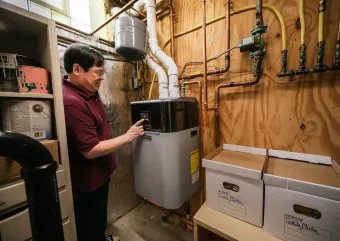Electrifying your home is a process, which is why we typically recommend you electrify one area at a time as the opportunities present themselves. Depending on your goals, though, we have recommendations for the order of projects that may make the most sense for you.
Why Are You Electrifying?
When we speak to residents about their electrification projects, we hear a lot about the projects they’re choosing and why they’ve chosen the order they have. Many of the residents we speak to have one of three reasons for their choices: reducing their home’s climate impact quickly, finding cost-effective electrification upgrades, or improving their indoor air quality. We’ve put together guides on how to achieve each of these goals. Click on your primary goal below to see projects that will have the biggest impact.
Use the anchor links below to quickly go to each section.
Climate Now
The Climate Now pathway prioritizes reducing your home’s greenhouse gas emissions quickly.
-
Weatherize Your Home
Weatherization includes insulation, air sealing, and potential window upgrades. These projects can significantly reduce emissions while preparing your home for a higher-efficiency electric heating system, which will be your second step.
-
Install a High-Efficiency Electric Heating System
Offset or replace a gas furnace or boiler with a high-efficiency heating system. Electrifying some or all of your heating is important to reduce emissions because 70% of the typical Minnesota home’s energy use goes toward heating.
-
Install an Electric Heat Pump Water Heater
After heating and cooling, water heating is typically the biggest user of energy in the home. Switching to a heat pump water heater will help you reduce your home’s emissions.
Easing In
The Easing In pathway recommends less expensive, easier-to-install upgrades first to help manage costs.
-
Install an Electric Clothes Dryer
Electric clothes dryers are relatively low cost and easy to install. Depending on the type of dryer you choose, it may not even need to be vented outside.
-
Install an Electric Cooking Range
There are multiple types of electric cooking ranges, and within those, you can choose more affordable or premier options. Before you electrify your cooktop, though, you may need to upgrade your plug to support the new appliance.
-
Install an Electric Heat Pump Water Heater
Heat pump water heaters have a larger upfront cost than traditional gas-burning options, but they are easier to install than other electrification measures.
Healthy and Safe Homes
The Healthy and Safe Homes pathway puts your indoor air quality first.
-
Install an Electric Cooking Range
Gas-burning ranges can release pollutants into the air, which negatively impact the health and breathing of the people in your home. By electrifying this appliance, you eliminate this source of pollution.
-
Install an Electric Heat Pump Water Heater
If your home has a natural gas water heater that’s been poorly installed or maintained, it could be spilling combustion exhaust into your home. Switching to a heat pump water heater eliminates combustion exhaust in the home.
-
Weatherize and Ventilate Your Home
When you seal your home against the elements through insulation, air sealing, and window upgrades, you should also ventilate the space to make sure you’re getting enough fresh air. Together, these projects will keep your home comfortable, indoor air fresh, and outdoor pollutants out.
Get Started Electrifying Today
No matter what electric technologies you use in your home, transitioning from a piece of gas-powered equipment to an electric one will help your home be more climate-friendly, healthier, and more comfortable. Our goal is to make the transition as seamless as possible with our guides to weatherization and electrification, our buyer’s guide, and our financial incentives tools. If you live in one of our partner communities and still have questions, email us or schedule a call to talk to an electrification advisor about your unique home and goals. If you live outside that region, we recommend getting an energy audit or contacting a contractor near you.
